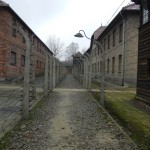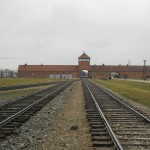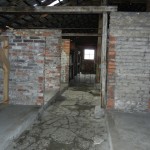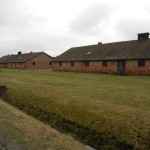During our one week break, three of the places we went to visit were Krakow, Poland, Auschwitz and Birkenau Concentration Camps, and Berlin, Germany. All of these places hold a lot of history and are places that I have always wanted to visit to be able to gain a better understanding of the Holocaust and the tragedies that occurred there. We have learned about the Holocaust ever since seventh grade, but learning about it in a textbook or reading a novel about it, and physically being there to witness the place where millions were murdered, give two totally different affects.
Our first trip was to Auschwitz early Friday morning. It was about an hour’s drive outside of Krakow. Once we arrived, it definitely was not what I imagined it to be. I expected Auschwitz to be more like Birkenau was. In reality, Auschwitz had more multistory brick buildings, rather than one level barracks, which is what I was expecting. We toured the rooms, seeing huge amounts of shoes and luggage, that in reality was only from one day’s worth of prisoners. The amounts of personal belongings are unbelievable.
As we toured, there was a large amount of Jewish people who were in different areas of the concentration camp saying prayers. Today, the only gas chamber that is still standing from WWII is in Auschwitz. While we were there, we had the opportunity to go inside the chamber. While walking through, there were a group of Jewish people saying prayers inside. It was a bit of an eerie feeling, hearing the prayers and being inside. It really made me think about what it must have been like for the Jews then, knowing that they were going to die and staying their final prayers. The prayers echoed throughout the chamber making the experience quite unreal.
After Auschwitz, we headed over to Birkenau and witnessed the ruins that were left. When the war was coming to an end and the Nazis knew they were going to lose, they bombed their gas chambers and many of the barracks to hide the evidence. There are many memorials around the grounds in remembrance of the lives that were taken and the ashes that are scattered throughout. In the barracks, we were able to see exactly what the living conditions were for the Jews. Not only could we see how small the bunks were but also all of the names and words carved into the walls. One person wrote, “We will never die” on one of the walls. Seeing that in itself, was a huge realization and eye opener as well.
Back in Krakow, there was a free tour that took us around the Jewish Quarters. We saw a lot of the places that were used to film Schindler’s List and we learned about how life really was back then for the Jewish people in Poland. Even today there is a large population of Jewish people that live in that area of Krakow, though nowhere near the amount that lived there back in the 1930s. As we were walking through and looking at all of these historic locations as well as different synagogues, I felt that we were not very welcomed or wanted by the current Jewish residents. I felt almost as if we were trespassing in their area and that we should not be there.
The trip itself was very rewarding and a great learning experience. There were many other places that we visited, such as the Topography of Terror Museum in Berlin, and many other places that we could have seen, but chose not to. At some point, there was just a limit about how much we could handle and witness because many of the days that we spent at the different concentration camps and museums did take a toll on our emotional state. Overall, it was an amazing experience and I do believe that it is important to visit these places to really understand what happened during WWII to the prisoners of the concentration camps.







Leave a Reply